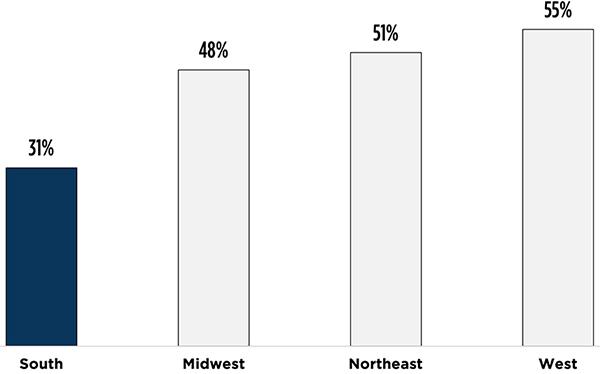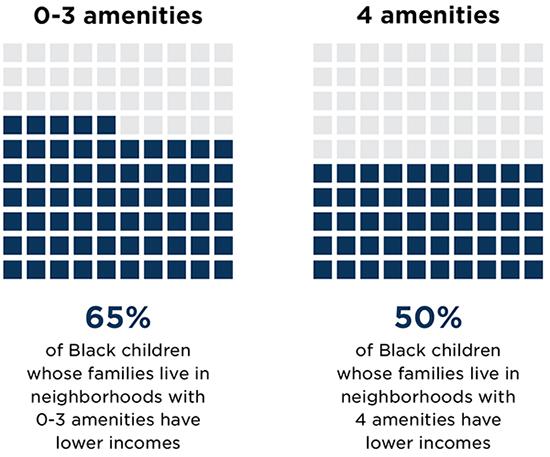This data analysis is one of two short products that analyze the relationship between the presence of key amenities in Black children and adolescents’ neighborhoods and the well-being of these young people and their families. Read the other analysis here.
According to our new analysis of data from the 2020-2021 National Survey of Children’s Health (NSCH),[1] most Black children in the United States live in neighborhoods that lack amenities associated with children’s healthy development and well-being—a legacy of residential segregation and other racial and environmental inequities. Black children’s access to these neighborhood amenities (sidewalks/walking paths, recreational centers, parks/playgrounds, and libraries/bookmobiles) differs by geographic location and family income. Black children with the lowest reported access to all four neighborhood amenities live in the South,[2] the region with the highest concentration of Black children and families.
Figure 1: Black children in the South have the lowest access to all four amenities associated with healthy childhood development and well-being, relative to Black children in other Census regions
Percentage of Black children, by Census region, whose neighborhoods feature sidewalks/walking paths, recreation centers, parks/playgrounds, and libraries/bookmobiles

Figure source: Authors’ analysis of 2020-2021 data from the National Survey of Children’s Health
Moreover, Black children living in neighborhoods with fewer than all four amenities present are more likely to have family incomes below 200 percent of the poverty threshold[3] (i.e., < $53,000 for a family of four) than to have family incomes at or above 200 percent of the poverty threshold. In neighborhoods with zero to three amenities, 65 percent of Black children have families whose incomes are below 200 percent of the poverty threshold (lower incomes), while in neighborhoods with all four amenities, 50 percent of Black children have families that have lower incomes.
Figure 2: Most Black children in neighborhoods with three or fewer amenities have families with lower incomes
The percentage of Black children whose families’ incomes are below 200% of the poverty threshold, by number of amenities* available in their neighborhoods

Figure source: Authors’ analysis of 2020-2021 data from the National Survey of Children’s Health
*Amenities are sidewalks/walking paths, recreation centers, parks/playgrounds, and libraries/bookmobiles
The benefits of these amenities for children’s and adolescents’ positive social, emotional, and physical well-being—and to their academic achievement—are well documented. Sidewalk access is associated with higher rates of physical activity and lower risks of childhood obesity, and provides children with safer routes to schools. Parks and playgrounds are related to higher rates of health-enhancing behaviors and adolescents’ mental health and resilience. Community recreational centers and community-based organizations like the YMCA/YWCA and the Boys and Girls Club provide safe, supervised out-of-school-time programs for children and youth that are linked to positive developmental outcomes such as internal self-regulation. Public libraries provide books, videos, games, and a variety of literacy programs for children and families. They also serve as community hubs, connecting children and adults with needed resources, services, and information. Among other benefits, library use is positively associated with students’ reading achievement. Despite these benefits, our analyses show that, in 2020-2021, over 60 percent of Black children (birth to age 17) did not live in neighborhoods with all four of these amenities. Of this 60 percent, about 8 percent lived in neighborhoods without any.
Given the association between neighborhood amenities and indicators of child well-being, more research is needed to examine how the presence of these amenities—and, in the case of recreational centers and libraries, the types of programming they offer—affects Black children across gender, age, location, and family income. Studies should also focus on the mediating and moderating effects of the quality of neighborhood amenities and other community-based protective factors on Black children’s and adolescents’ healthy development. This research should include methods and instruments that center the voices of the Black children and families who live, work, and grow in these communities. Such studies can inform cross-sector initiatives that view children’s well-being holistically (like those following the Health in All Policies or Life Course Health Development frameworks), strengthening efforts to create healthy, sustainable, and equitable communities for Black children, especially those experiencing poverty and living in the South.
Footnotes
[1] The NSCH is a national survey, funded and directed by the Health Resources and Services Administration’s Maternal and Child Health Bureau (HRSA MCHB), that provides rich data on multiple intersecting aspects of children’s health and well-being—including physical and mental health, access to and quality of health care, and the child’s family, neighborhood, school, and social contexts. Primary results are based on chi square analyses using STATA statistical software version 16. Analyses were conducted using weighted estimates for 2020 and 2021. For the relevant indicators, adjustments were made for missing data using listwise deletion. Respondents were those who identified as Black or African American alone and Black with Hispanic or Latino origin.
[2] The U.S. Census Bureau’s definition of the South, used throughout this blog post, includes Alabama, Arkansas, Delaware, Florida, Georgia, Kentucky, Louisiana, Maryland, Mississippi, North Carolina, Oklahoma, South Carolina, Tennessee, Texas, Virginia, West Virginia, and Washington, DC.
[3] 2021 poverty guidelines for the 48 contiguous states and the District of Columbia. https://aspe.hhs.gov/2021-poverty-guidelines
Suggested citation
Sanders, M., Winston, J., & Rochester, S.E. (2023). Most Black children live in neighborhoods that lack amenities associated with child well-being. Child Trends. https://www.childtrends.org/blog/most-black-children-live-in-neighborhoods-that-lack-amenities-associated-with-child-well-being
© Copyright 2025 ChildTrendsPrivacy Statement
Newsletter SignupLinkedInYouTubeBlueskyInstagram

